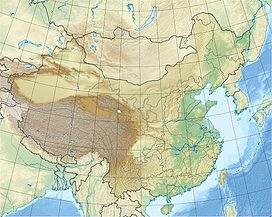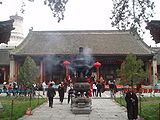- Mount Wutai
-
Mount Wutai 五台山 
Mount Wutai from the airElevation 3,058 m (10,033 ft) Translation Five Plateau Mountain (Chinese) Location Wutai County, Xinzhou city, Shanxi, China Coordinates 39°04′45″N 113°33′53″E / 39.07917°N 113.56472°ECoordinates: 39°04′45″N 113°33′53″E / 39.07917°N 113.56472°E Climbing Easiest route Hike Mount Wutai (Chinese: 五台山; pinyin: Wǔtái Shān; literally "Five Plateau Mountain"), also known as Wutai Mountain or Qingliang Shan, is located in Shanxi, China. The mountain is home to many of China's most important monasteries and temples. Mount Wutai is home to 53 sacred monasteries, and they were inscribed as a UNESCO World Heritage Site in 2009.[1]
It takes its name from its unusual topography, consisting of five rounded peaks (North, South, East, West, Central), of which the North peak, called Beitai Ding or Yedou Feng, is the highest, and indeed the highest point in northern China.
Contents
Introduction
Mount Wǔtái is one of the Four Sacred Mountains in Chinese Buddhism. Each of the four mountains are viewed as the abode or place of practice (dàocháng; 道場) of one of the four great bodhisattvas. Wǔtái is the home of the Bodhisattva of wisdom, Manjusri or Wénshū (文殊) in Chinese.
Wǔtái was the first of the four mountains to be identified and is often referred to as "first among the four great mountains." It was identified on the basis of a passage in the Avatamsaka Sutra (Ch: Húayán jīng; 華嚴經), which describes the abodes of many bodhisattvas. In this chapter, Manjusri is said to reside on a "clear cold mountain" in the northeast. This served as charter for the mountain's identity and its alternate name "Clear Cool Mountain" (Ch: Qīngliáng Shān; 清涼山).
The bodhisattva is believed to frequently appear on the mountain, taking the form of ordinary pilgrims, monks, or most often unusual five-colored clouds.
Mount Wǔtái has an enduring relationship with Tibetan Buddhism.[2]
Mount Wǔtái is home to some of the oldest existent wooden buildings in China that have survived since the era of the Tang Dynasty (618–907). This includes the main hall of Nanchan Temple and the East Hall of Foguang Temple, built in 782 and 857, respectively. They were discovered in 1937 and 1938 by a team of architectural historians including the prominent early 20th century historian Liang Sicheng. The architectural designs of these buildings have since been studied by leading sinologists and experts in traditional Chinese architecture, such as Nancy Steinhardt. Steinhardt classified these buildings according to the hall types featured in the Yingzao Fashi Chinese building manual written in the 12th century.
In 2008, there were complaints from local residents that in preparation for Mount Wutai's bid to become a UNESCO World Heritage Site, they were forced from their homes and relocated away from their livelihoods.[3]
Major Temples
Mount Wutai * UNESCO World Heritage Site
Country  China
ChinaType Cultural/natural Criteria ii, iii, iv, vi Reference 1279 Region ** Asia-Pacific Inscription history Inscription 2009 (33rd Session) * Name as inscribed on World Heritage List
** Region as classified by UNESCONanshan Temple (Chinese: 南山寺) is a large temple in Mount Wǔtái, first built in the Yuan Dynasty. The whole temple comprises seven terraces, divided into three parts. The lower three terraces are named Jile Temple (极乐寺); the middle terrace is called Shande Hall (善德堂); the upper three terraces are named Youguo Temple (佑国寺). Other major temples include Xiantong Temple, Tayuan Temple and Pusading Temple.
Other important temples inside Mount Wutai include: Shouning Temple, Bishan Temple, Puhua Temple, Dailuo Ding, Qixian Temple, Shifang Tang, Shuxiang Temple, Guangzong Temple, Yuanzhao Temple, Guanyin Dong, Longquan Temple, Luomuhou Temple, Jinge Temple, Zhenhai Temple, Wanfo Ge, Guanhai Temple, Zhulin Temple, Jifu Temple, Gufo Temple, etc.
Outer Mount Wutai temples include: Yanqing Temple, Nanchan Temple, Mimi Temple, Foguang Temple, Yanshan Temple, Zunsheng Temple, Guangji Temple, etc.
Transportation
The Wutaishan Airport is currently under construction in nearby Dingxiang County, and is expected to open in 2012.
Further Reading
China's Holy Mountain: An Illustrated Journey into the Heart of Buddhism by Christoph Baumer. I.B.Tauris, London 2011. www.ibtauris.com ISBN 9781848857001
Notes
- ^ China’s sacred Buddhist Mount Wutai inscribed on UNESCO’s World Heritage List. UNESCO World Heritage Centre
- ^ Tuttle, Gray (2006). 'Tibetan Buddhism at Ri bo rtse lnga/Wutai shan in Modern Times.' Journal of the International Association of Tibetan Studies, no. 2 (August 2006): 1-35. Source: [1] (accessed: Saturday, April 11, 2009)
- ^ [2][3]
Gallery
-
A 10th century mural from Cave 61 of the Mogao Caves in Dunhuang, showing monasteries of Mount Wutai
-
The Sarira Stupa of Tayuan Temple, built in 1582 during the Ming Dynasty
External links
Sacred Mountains of China Five Great Mountains Four Sacred Buddhist Mountains Four Taoist Mountains World Heritage Sites in China East Classical Gardens of Suzhou · Fujian Tulou · Lushan National Park · Mount Huang (Huangshan) · Mount Sanqing (Sanqingshan) · Mount Tai (Taishan) · Mount Wuyi (Wuyishan) · Temple and Cemetery of Confucius and Kong Family Mansion, Qufu · Ancient villages in Southern Anhui - Xidi and Hongcun · West Lake Cultural Landscape of Hangzhou
South Central Ancient Building Complex in the Wudang Mountains · Historic Centre of Macau · Kaiping Diaolou and Villages · Longmen Grottoes · Historic Monuments of Dengfeng, including the Shaolin Monastery and Gaocheng Observatory · Wulingyuan Scenic and Historic Interest Area · Yin Xu
Southwest Dazu Rock Carvings · Historic Ensemble of the Potala Palace, including the Jokhang and Norbulingka · Huanglong Scenic and Historic Interest Area · Jiuzhaigou Valley Scenic and Historic Interest Area · Old Town of Lijiang · Mount Emei Scenic Area, including Leshan Giant Buddha Scenic Area · Mount Qingcheng and the Dujiangyan Irrigation System · Sichuan Giant Panda Sanctuaries · Three Parallel Rivers of Yunnan Protected Areas
North Mount Wutai (Wutaishan) · Chengde Mountain Resort and its outlying temples including the Putuo Zongcheng Temple, Xumi Fushou Temple and the Puning Temple · Imperial Palaces of the Ming and Qing Dynasties in Beijing and Shenyang · Peking Man Site at Zhoukoudian · Ancient City of Pingyao · Summer Palace, an Imperial Garden in Beijing · Temple of Heaven: an Imperial Sacrificial Altar in Beijing · Yungang Grottoes
Northeast Capital Cities and Tombs of the Ancient Koguryo Kingdom · Imperial Palaces of the Ming and Qing Dynasties in Beijing and Shenyang
Northwest Multiple regions National parks of China Beidaihe • Benxi Shuidong National Park • Mount Cangyan • Chengde Mountain Resort • Dian Lake • Dujiangyan Irrigation System • Mount Emei • Fuxian Lake • Mount Heng (Hunan) • Mount Heng (Shanxi) • Hexigten Global Geopark • Mount Hua • Huangguoshu Waterfall • Huanglong, Sichuan • Mount Huang • Jade Dragon Snow Mountain • Jinggangshan Mountains • Jiuzhaigou Valley • Mount Lao • Mount Li • Longmen Grottoes • Mount Luofu • Mount Lu • Lushan Quaternary Glaciation National Geopark • Mount Jiuhua • Mount Mogan • Pearl Shoal Waterfall • Pudacuo National Park • Mount Putuo • Qianshan National Park • Mount Qingcheng • Qinghai Lake • Mount Qingyuan • Mount Qiyun • Mount Sanqing • Sanshan Islands • Shilin (Stone Forest) • Mount Song • Taihu Lake • Mount Tai • Mount Tianzhu • Wudang Mountains • Wulingyuan • Mount Wutai • Wuyi Mountains • Xixi National Wetland Park • Yuelu Mountain • Yun Mountain • Zhangjiajie National Forest Park • Wangwushan - Yuntaishan National Park •Shanxi topics General Geography Cities • Taihang Mountains • Lüliang Mountains • Yellow River • Fen River • Mount Wutai • Mount Hua • Great Wall of China • Xiechi LakeEducation Culture Visitor attractions Categories:- Mountains of China
- Sacred mountains
- National parks of China
- Geography of Shanxi
- Geoparks
- Buddhism in China
Wikimedia Foundation. 2010.








